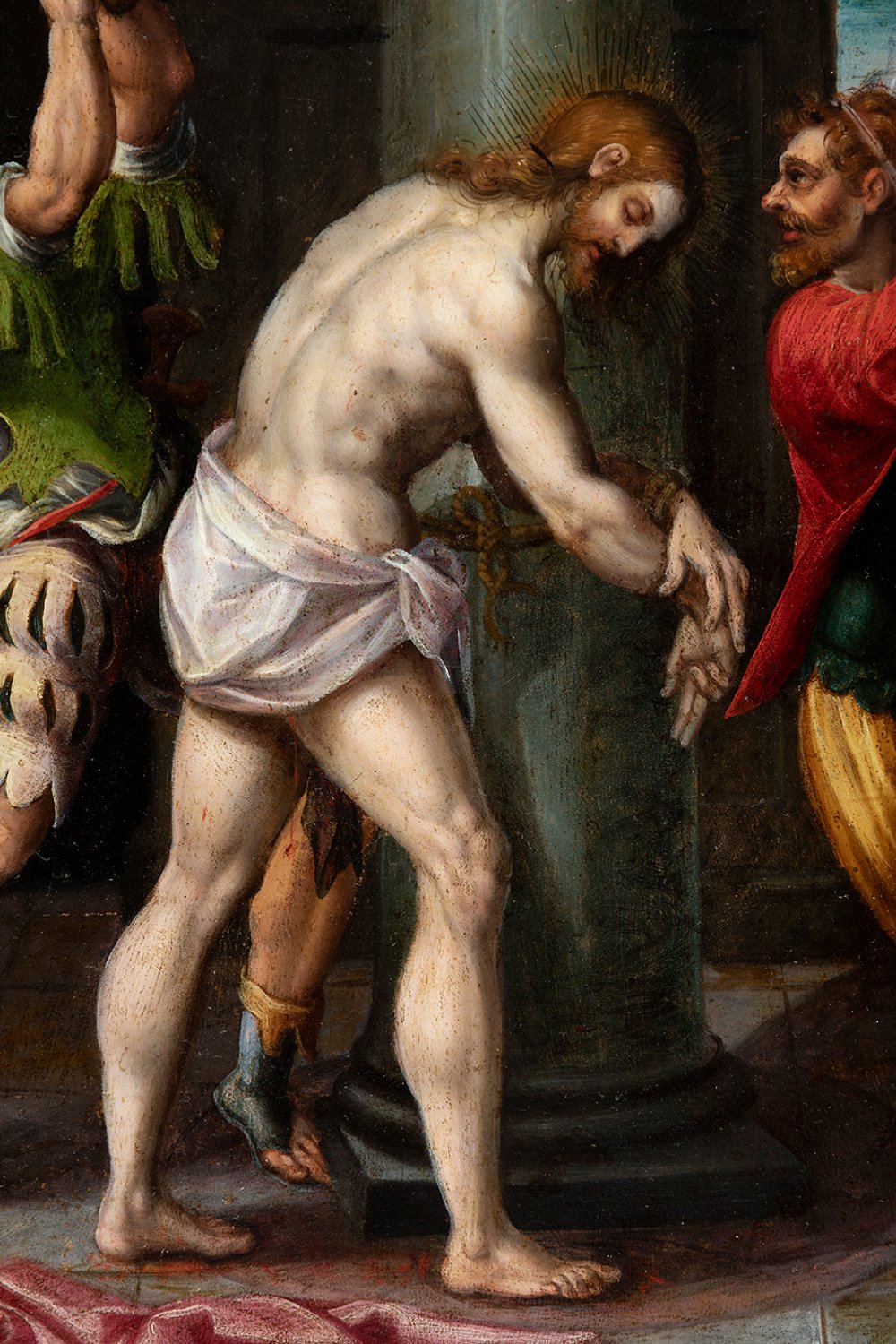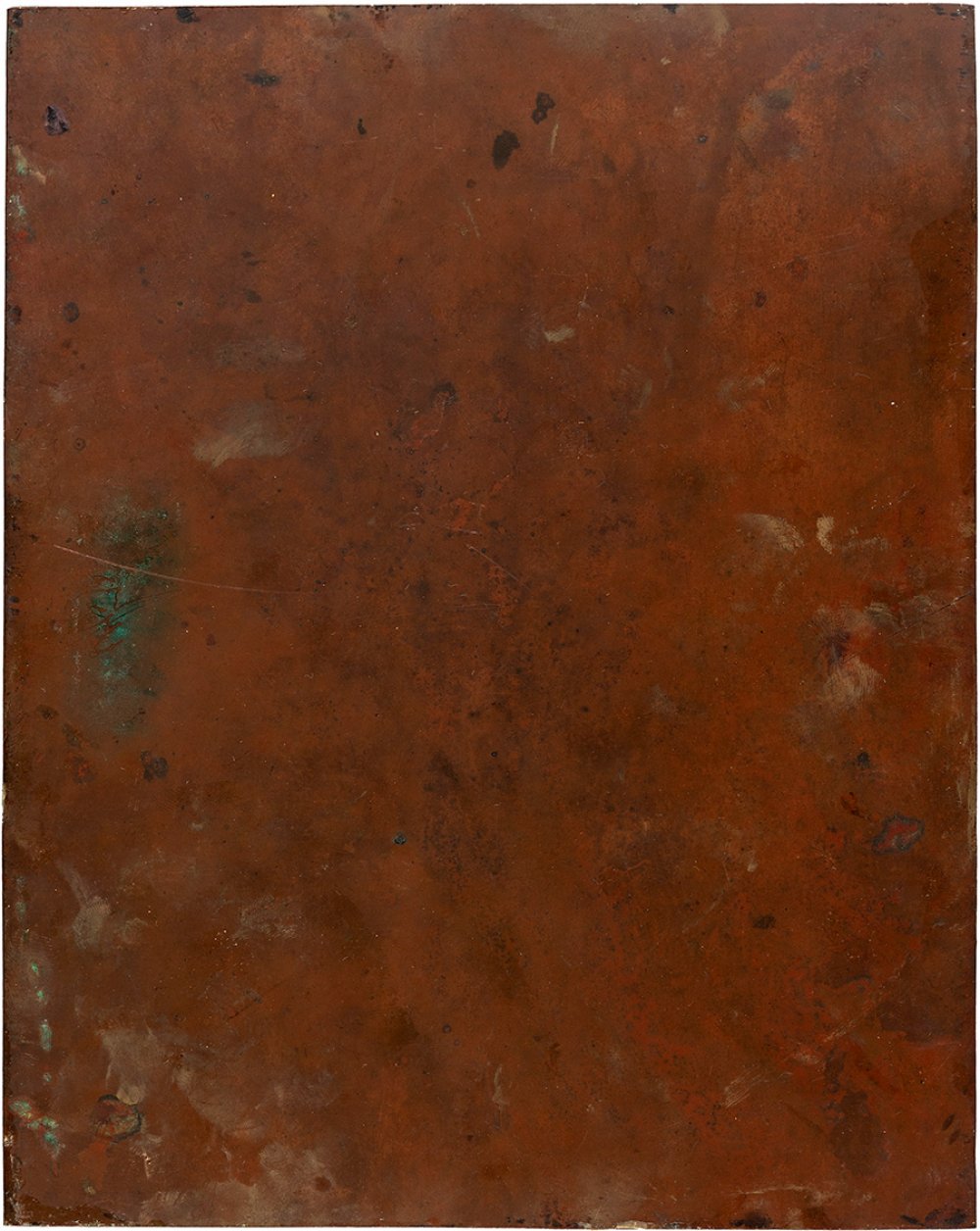39
Flemish school of the early 17th century."The Flagellation of Christ".Oil on copper.Measurements: 25
1/4
Description
Flemish school of the early 17th century.
"The Flagellation of Christ".
Oil on copper.
Measurements: 25 x 19.5 cm; 28.5 x 23.5 cm (frame).
In this copper the theme of the scourging of Christ is approached following a compositional scheme influenced by the long Italian tradition, with Jesus tied to the column in the centre of the scene, although it belongs to the Flemish school due to its technique and morphology. The event takes place in an open marbled interior, with an open window allowing a view of the exterior. Two soldiers scourge Jesus, while he is already wearing the cloth of purity, fastened with a rope, and his hands are tied to a tall column. The result is a totally narrative scene, highly expressive and dynamic, which introduces depth into the foreground and perfectly summarises the action.
As for its iconography, all four Gospels mention the punishment that Christ suffers at this moment, although they make no reference to any pillar: this iconography arises from the word "chastisement" used by Luke, and was known as a moment prior to the Crucifixion in the words of Josephus, for example. Throughout the Middle Ages the column venerated in Jerusalem was used for these representations, characterised by its height. There is another typology, however, which closely follows the model of the relic preserved in Santa Praxedes in Rome since 1233 and which the Council of Trent was responsible for recovering for art, characterised precisely by the marble in which it is made and by its low height. This model of column, which does not deny the previous one as theologians recognise two moments in which Christ was flaged, was used in art from the end of the 16th century, coexisting with the high one, and spread rapidly throughout Europe.
"The Flagellation of Christ".
Oil on copper.
Measurements: 25 x 19.5 cm; 28.5 x 23.5 cm (frame).
In this copper the theme of the scourging of Christ is approached following a compositional scheme influenced by the long Italian tradition, with Jesus tied to the column in the centre of the scene, although it belongs to the Flemish school due to its technique and morphology. The event takes place in an open marbled interior, with an open window allowing a view of the exterior. Two soldiers scourge Jesus, while he is already wearing the cloth of purity, fastened with a rope, and his hands are tied to a tall column. The result is a totally narrative scene, highly expressive and dynamic, which introduces depth into the foreground and perfectly summarises the action.
As for its iconography, all four Gospels mention the punishment that Christ suffers at this moment, although they make no reference to any pillar: this iconography arises from the word "chastisement" used by Luke, and was known as a moment prior to the Crucifixion in the words of Josephus, for example. Throughout the Middle Ages the column venerated in Jerusalem was used for these representations, characterised by its height. There is another typology, however, which closely follows the model of the relic preserved in Santa Praxedes in Rome since 1233 and which the Council of Trent was responsible for recovering for art, characterised precisely by the marble in which it is made and by its low height. This model of column, which does not deny the previous one as theologians recognise two moments in which Christ was flaged, was used in art from the end of the 16th century, coexisting with the high one, and spread rapidly throughout Europe.
Auction Details
Shipping
T&Cs & Important Info
Ask seller a question
Flemish school of the early 17th century.
"The Flagellation of Christ".
Oil on copper.
Measurements: 25 x 19.5 cm; 28.5 x 23.5 cm (frame).
In this copper the theme of the scourging of Christ is approached following a compositional scheme influenced by the long Italian tradition, with Jesus tied to the column in the centre of the scene, although it belongs to the Flemish school due to its technique and morphology. The event takes place in an open marbled interior, with an open window allowing a view of the exterior. Two soldiers scourge Jesus, while he is already wearing the cloth of purity, fastened with a rope, and his hands are tied to a tall column. The result is a totally narrative scene, highly expressive and dynamic, which introduces depth into the foreground and perfectly summarises the action.
As for its iconography, all four Gospels mention the punishment that Christ suffers at this moment, although they make no reference to any pillar: this iconography arises from the word "chastisement" used by Luke, and was known as a moment prior to the Crucifixion in the words of Josephus, for example. Throughout the Middle Ages the column venerated in Jerusalem was used for these representations, characterised by its height. There is another typology, however, which closely follows the model of the relic preserved in Santa Praxedes in Rome since 1233 and which the Council of Trent was responsible for recovering for art, characterised precisely by the marble in which it is made and by its low height. This model of column, which does not deny the previous one as theologians recognise two moments in which Christ was flaged, was used in art from the end of the 16th century, coexisting with the high one, and spread rapidly throughout Europe.
"The Flagellation of Christ".
Oil on copper.
Measurements: 25 x 19.5 cm; 28.5 x 23.5 cm (frame).
In this copper the theme of the scourging of Christ is approached following a compositional scheme influenced by the long Italian tradition, with Jesus tied to the column in the centre of the scene, although it belongs to the Flemish school due to its technique and morphology. The event takes place in an open marbled interior, with an open window allowing a view of the exterior. Two soldiers scourge Jesus, while he is already wearing the cloth of purity, fastened with a rope, and his hands are tied to a tall column. The result is a totally narrative scene, highly expressive and dynamic, which introduces depth into the foreground and perfectly summarises the action.
As for its iconography, all four Gospels mention the punishment that Christ suffers at this moment, although they make no reference to any pillar: this iconography arises from the word "chastisement" used by Luke, and was known as a moment prior to the Crucifixion in the words of Josephus, for example. Throughout the Middle Ages the column venerated in Jerusalem was used for these representations, characterised by its height. There is another typology, however, which closely follows the model of the relic preserved in Santa Praxedes in Rome since 1233 and which the Council of Trent was responsible for recovering for art, characterised precisely by the marble in which it is made and by its low height. This model of column, which does not deny the previous one as theologians recognise two moments in which Christ was flaged, was used in art from the end of the 16th century, coexisting with the high one, and spread rapidly throughout Europe.
29th December - Old Masters
Sale Date(s)
Venue Address
Aragón 346, Barcelona
Calle Velázquez 7, Madrid
Carrer de Cirilo Amorós 55, Valencia
Barcelona
08009
Spain
General delivery information available from the auctioneer
Setdart offers Worldwide shipping
PICK UP IN ROOM: You can come and pick up your lots in our offices (Barcelona, Madrid or Valencia). At the moment of the withdrawal, you will be able to accept the current conditions of the lot by means of a document that you will sign.
YOU CAN SEND ANOTHER PERSON TO PICK UP: This person must present a signed authorization that you can find in our web page by accessing from BUY AT SETDART- LOGISTICS-DOWNLOAD AUTHORIZATION DOCUMENT. You can also send an e-mail with the requested data in AUTHORIZATION DOCUMENT to admin@setdart.com
Important Information
25% buyer´s premium
21% buyer´s premium at www.setdart.com












